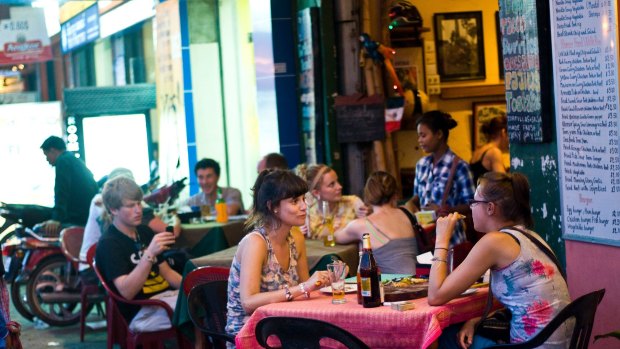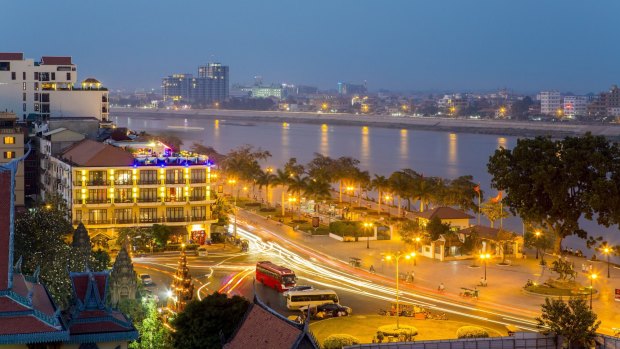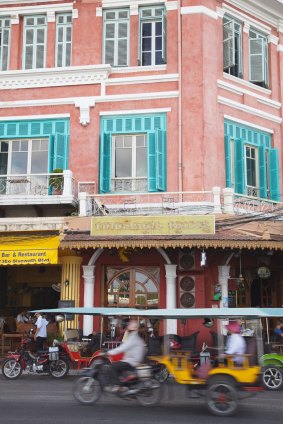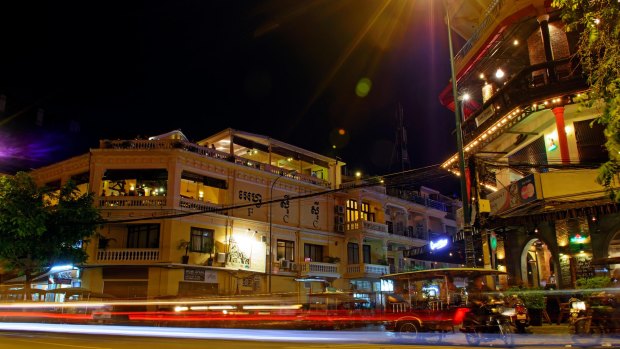This was published 8 years ago
Cambodia, southeast Asia: Phnom Penh's new riverside precinct
Julie Miller wanders Phnom Penh's vibrant riverside precinct and finds it has been transformed from seedy to sensational.
By Julie Miller

Customers at a restaurant on Sisowath Quay.Credit: Alamy
Daylight is fading over the confluence of the Tonle Sap and Mekong rivers, but along the palm-lined promenade, the carnival has come to town.
Young families perch on wooden benches, ice-creams dripping, as rollerbladers, marigold-clad monks and teens-with-attitude saunter by, enjoying their daily constitutional in the sultry evening air. An aerobics class bounces on a manicured patch of grass, while balloon and street-food vendors jostle for kerbside position.
From the balcony of the Foreign Correspondents Club, I gaze at the entertainment below, absorbing the energy of this chaotic, youthful town. Clawing its way out of the carnage of the Khmer Rouge regime, Phnom Penh has become one of south-east Asia's most vibrant cities, the spoils of new-found prosperity evident in glistening skyscrapers and a staggering number of luxury cars dodging potholes in roads still under construction.

Sisowath Quay on Tonle Sap River.Credit: hemis.fr
At the heart of the transformation is Sisowath Quay, the three-kilometre strip lining the riverfront. Twenty years ago, this was a seedy no-go zone, the domain of "thieves and vagabonds" where many an AK-47 was fired, either in civil warfare or drunken tomfoolery.
"The river was a place you'd never come at night – it was scary," FCC founder Steve Hayward says. "In those days, there was nothing but warehouses and Chinese emporiums – no one thought of the river as a great view."
Hayward and his entrepreneurial partners were the first to nab prime waterfront real estate for the now-legendary bar; and it's partly due to the infamy of the titular journalists' club that the quay and surrounding streets have become a hot spot, their restored colonial buildings housing cocktail bars, hip restaurants and boutiques filled with the creations of young local designers.

Restaurants on Sisowath Quay, Phnom Penh.Credit: Alamy
To begin my exploration of the area, I ask the tuk-tuk driver to drop me outside the Royal Palace, home to the King of Cambodia and arguably Phnom Penh's biggest tourist attraction. The Silver Pagoda and the throne room are not on today's agenda, however; I'm headed instead for the streets flanking the palace, conveniently numbered to assist in navigation.
Until recently an unremarkable, tree-lined row of colonial residences, Street 240, on the far side of the palace, has been the heart of Cambodian cool, with a collection of wine bars, shops and cafes frequented by the city's bohemian expat community. A French restaurant, a chocolate maker and a Belgian-owned bakery add a continental flavour; while the Antipodes are represented by Australian-owned Spa Bliss (www.blissspacambodia.com), and a speakeasy called bar.sito run by Kiwis William Norbert Munns (formerly of Guillaume and Icebergs in Sydney) and his brother George.
Next door, in an unmarked alley known as 240 and a Half, is ARTillery, a popular vegan cafe that doubles as an exhibition space.

Sisowath Quay and the Foreign Correspondent's Club in Phnom Penh.Credit: Alamy
After pausing here for a coconut and pineapple smoothie (sipped through a sustainable bamboo straw), I dodge the queues outside the Royal Palace and head for Street 178 or "Art Street". Opposite the National Museum of Cambodia, this strip of galleries, silk shops and boutiques showcases the best of Khmer art and design, with favourites including Silk & Pepper (gorgeous Khmer handicrafts, silkandpepper.com), Garden of Desire (silver jewellery created by Khmer Rouge survivor Pisith Ly, www.gardenofdesire-asia.com) and Senteurs d'Angkor (facebook.com/senteursdangkor) with stocks of Kampot pepper, scented candles and beautifully packaged spa products.
Then there is the delightful Daughters of Cambodia (www.daughtersofcambodia.org), a women's co-operative that provides new career options in retail, sewing, jewellery making and hospitality for victims of the sex trade. Although relatively expensive (prices are in US dollars), the beautiful, hand-made clothing and accessories in the ground-floor boutique are well worth the outlay, with every item on sale produced at the charity's operation centre in Phnom Penh's red light district.
Daughters of Cambodia is just one of many fair-trade social enterprises in Phnom Penh offering opportunities to disadvantaged young people. Friends 'N' Stuff (on Street 13, a block back from Sisowath Quay) sells funky souvenirs created by street kids, with many of the products sourced from recycled materials; next door is the Friends restaurant, a training establishment run by marginalised youth. The highly acclaimed Romdeng, in a beautiful colonial building on Street 174, is another Friends enterprise, serving traditional and contemporary Cambodian cuisine, including fried tarantulas (www.friends-international.org).
As the heat sets in, the tourists vanish from the streets, seeking respite in airconditioned hotels. Forgoing my siesta, I pop across the road from Friends for an hour's foot massage at Seeing Hands, a no-frills massage centre run by blind practitioners.
Perhaps it's true that the loss of one sense heightens others – I can say without reservation that this was a superior massage, slow, deliberate and studied, with extreme sensitivity without sacrificing a firm touch. For $10, it's a bargain experience – plus it's heartening to know that the staff receive higher-than-average wages as well as the chance for an independent lifestyle.
Relaxed and reinvigorated, I continue my retail therapy on Street 13 at a cool vintage clothing store named Color (www.colorvintage.wordpress.com), picking up a cute '50s-style floral dress for $7. A few doors down, the retro trend is given a modern twist at the eclectic Trunkh (www.trunkh.com), a kaleidoscope of rusting junk repurposed into household items, quirky gifts and unusual clothing items.
Sunset draws the crowds back to the quay, with seemingly every tourist heading for FCC's two-for-one happy hour. From there, it's on to one of the many restaurants gracing the area, with all budgets and cuisines covered in an increasingly innovative dining scene.
One of the trendiest riverside digs is Metro, offering modern Asian-fusion tasting plates and delicious cocktails; while traditionalists make a beeline to Raffles Le Royal's legendary Elephant Bar to sip Femme Fatales, Jackie O's cocktail of choice.
Perhaps the nicest way to end the day, however, is with the locals at the riverside night market: order grilled seafood skewers (three for $2.80) from a street vendor, grab a 50-¢ Angkor beer and find a space on the rattan mats. Delicious, cheap and a classic Sisowath Quay experience.
TRIP NOTES
GETTING THERE
Thai Airways flies from Sydney and Melbourne to Bangkok, with transfers to Phnom Penh. See www.thaiairways.com. There are also Air Asia flights from Bangkok to Phnom Penh. See www.airasia.com
STAYING THERE
Raffles Le Royal Phnom Penh offers classic colonial-style luxury from $360 a night plus taxes. See www.raffles.com/phnom-penh
The writer was a guest of Raffles Le Royal Phnom Penh.
Sign up for the Traveller Deals newsletter
Get exclusive travel deals delivered straight to your inbox. Sign up now.